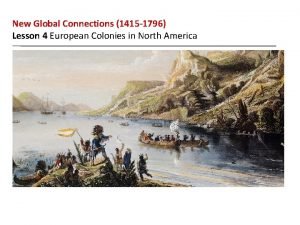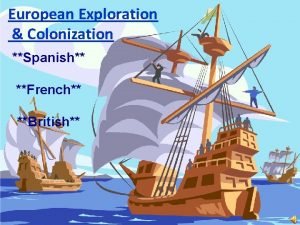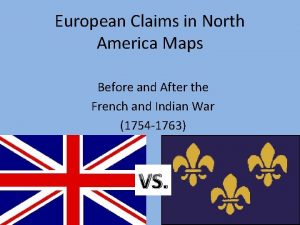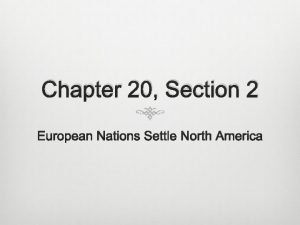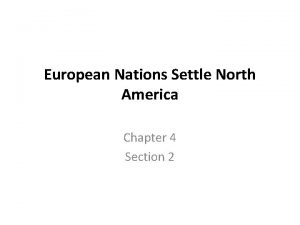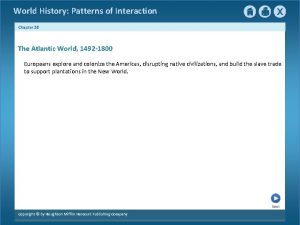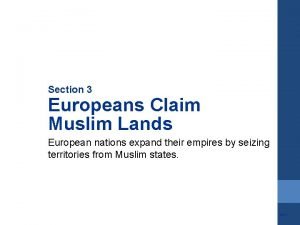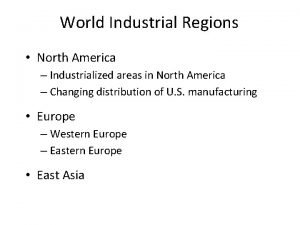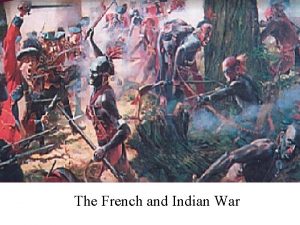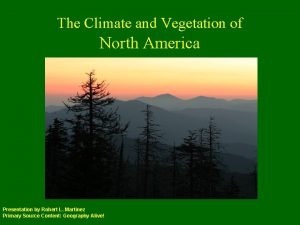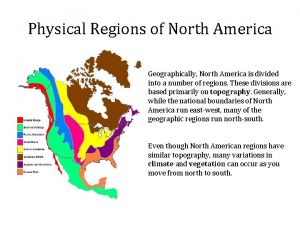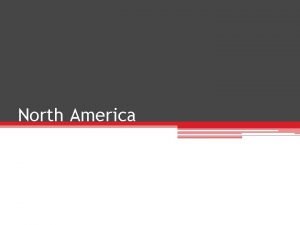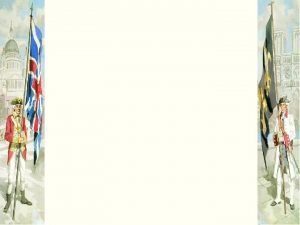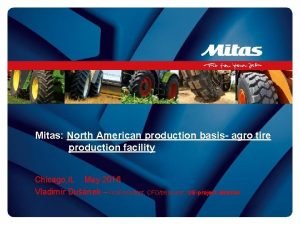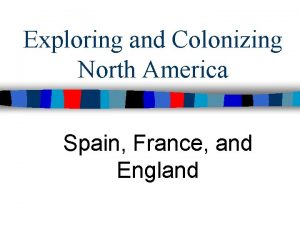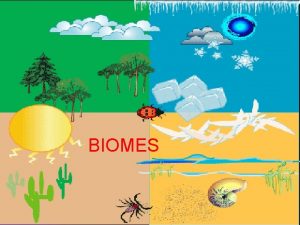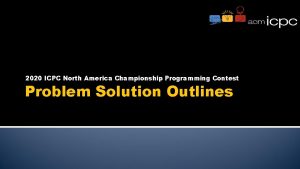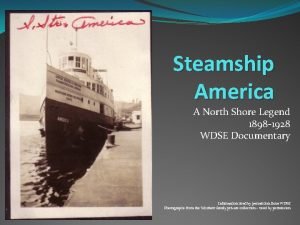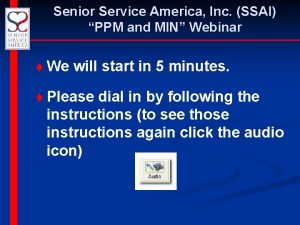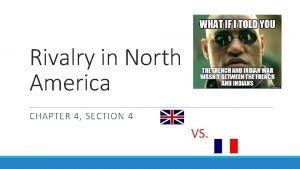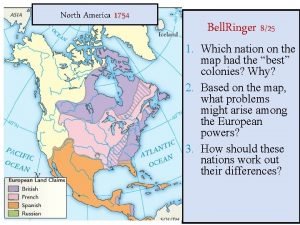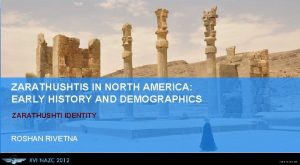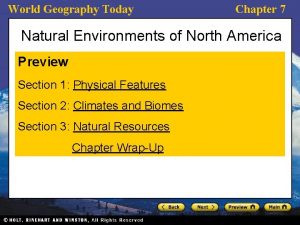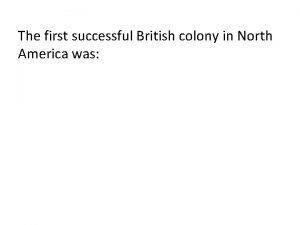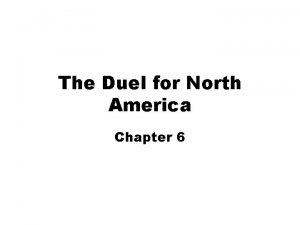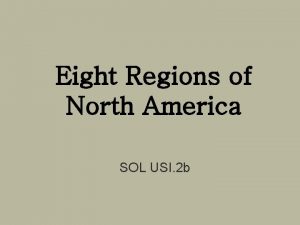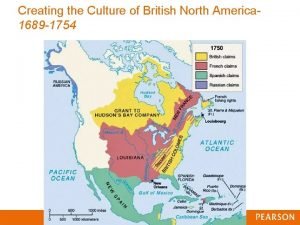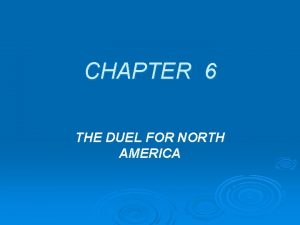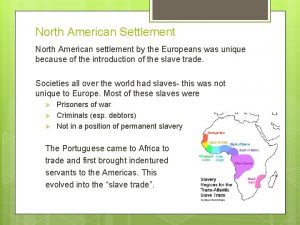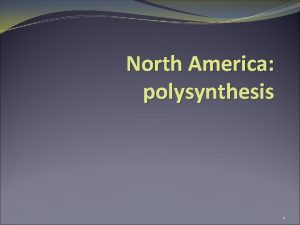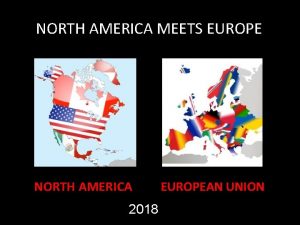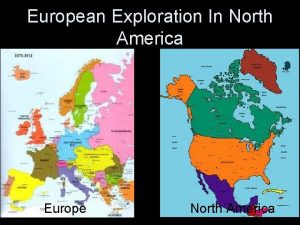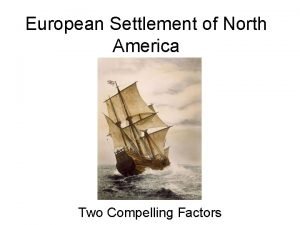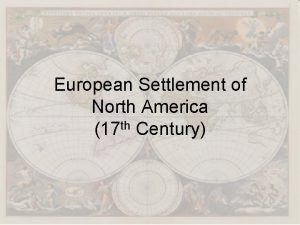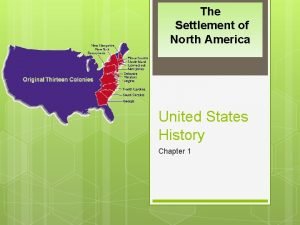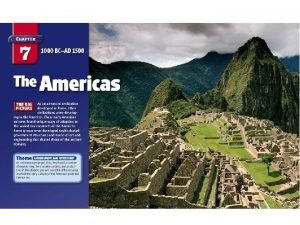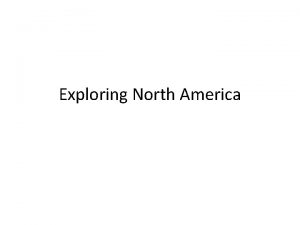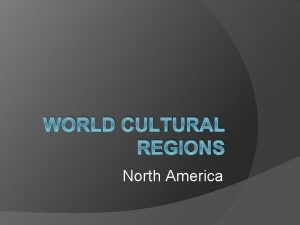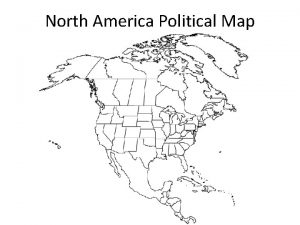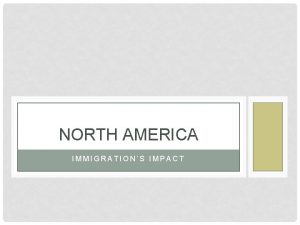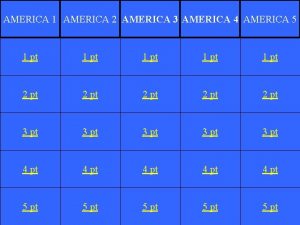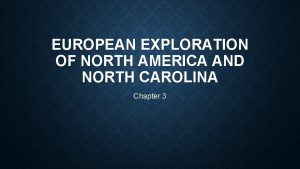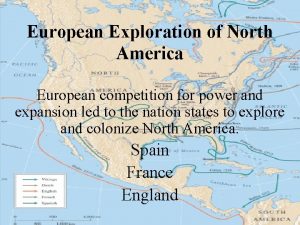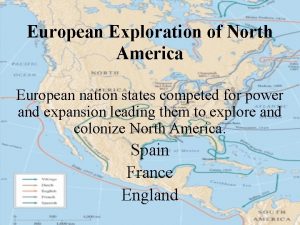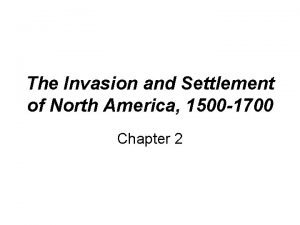EUROPEAN SETTLEMENT OF NORTH AMERICA WHAT IS HISTORY










































- Slides: 42

EUROPEAN SETTLEMENT OF NORTH AMERICA

WHAT IS HISTORY? ? • Prologue, After the Fact • Point of View (ATF 1)

Guiding Question 1 Why did people settle in the British North American colonies? Did people come for primarily economic concerns or for religious/idealistic motivations?

Guiding Question 2 Why and How did the British North American colonies develop into distinctively different societies and economies? Regions: (1) the Chesapeake and Lower South, (2) New England, (3) Mid -Atlantic.

American Colonies at the End of the Seventeenth Century

VIRGINIA CHESAPEAKE

Virginia Company, Charter, 1606

Chesapeake Bay & Jamestown

Settlement of Virginia • • • Virginia Company Jamestown John Smith John Rolfe Tobacco • House of Burgesses • indentured servants • headright system • “starving time” Jamestown Settlement (Computer Generated)

Early Colonial Tobacco 1618 — Virginia produces 20, 000 pounds of tobacco. 1622 — Despite losing nearly one-third of its colonists in an Indian attack, Virginia produces 60, 000 pounds of tobacco. 1627 — Virginia produces 500, 000 pounds of tobacco. 1629 — Virginia produces 1, 500, 000 pounds of tobacco.

Tobacco Prices 16181710

Life in Early Virginia, 1620 -1670 s • • • “plantations” society economy quality of life religion? River Plantations in Virginia, c. 1640

th 17 Century Population in the Chesapeake

Social Unrest in the Chesapeake • Bacon’s rebellion – causes • Backcountry settlement and Protection • Power of “eastern” elites and Taxation – significance Bacon’s rebellion in Virginia, 1676

Significance of Bacon’s Rebellion • First large rebellion in colonies (political & social) • Social/political conflict: “eastern” elites vs. backcountry • Catalyst in transition from indentured servitude to slavery

Reasons for Slavery • Decrease in indentured servants – English economy • Increase in availability of slaves – end of Royal African company monopoly – Decrease in price • Fears of growing number of landless freemen • Available supply from Caribbean

Population of Chesapeake Colonies: 16101750

The Atlantic Slave Trade “middle passage”

Slave Colonies of the Seventeenth and Eighteenth Centuries


Slavery • Where was slavery legal? In which colonies did it exist? Africans as a Percentage of Total Population of the British Colonies, 1650 – 1770

The Chesapeake Colonies in the Seventeenth Century

Deep South • • The West Indies and Carolina in the Seventeenth Century Carolina (1682) Georgia (1738) rice indigo Rice Indigo

Spread of Settlement: British Colonies, 1650– 1700

NEW ENGLAND

American Colonies at the End of the Seventeenth Century

English Migration, 1610 -1660

Plymouth • • Separatists “Pilgrims” Plymouth Mayflower Compact Mayflower II

Massachusetts Bay • Puritans • Great Migration • “City upon a hill”

New England • • • towns town meetings church Education “Old Satan Deluder” Act (1647) • Harvard College (1636) • merchants Land Division in Sudbury, MA: 1639 -1656

Population of the New England Colonies

Puritan “Rebels” Roger Williams Anne Hutchinson

New England Colonies, 1650

King Philip’s War, 1675 – 1676)

MIDDLE COLONIES

Colonies in Eastern North America 1650

New York • New Netherland (1613) – Who? Why? • Patroonships >>> • New York (1664) • society • economy

Pennsylvania • • • William Penn Quakers society economy Indian relations Royal Land Grant to Penn

Middle Colonies, 1685

Area of English settlement by 1700

American Colonies at the End of the Seventeenth Century

Britain's American Empire, 1713
 European colonies in north america
European colonies in north america New exploration
New exploration European claims in north america
European claims in north america European nations settle north america
European nations settle north america Chapter 20 section 2 european nations settle north america
Chapter 20 section 2 european nations settle north america Chapter 20 section 1 world history
Chapter 20 section 1 world history Europeans claim muslim lands
Europeans claim muslim lands Chapter 20 section 2 european nations settle north america
Chapter 20 section 2 european nations settle north america Europe asia north america south america
Europe asia north america south america We can do a rap of the map of the us
We can do a rap of the map of the us Whats an onomatopeia
Whats an onomatopeia Why called latin america
Why called latin america Happening body art
Happening body art Industrial region in north america
Industrial region in north america Why are cold fronts steeper than warm fronts
Why are cold fronts steeper than warm fronts French and indian war
French and indian war North america vegetation zones
North america vegetation zones Physical regions of north america
Physical regions of north america Ottawa on map of north america
Ottawa on map of north america South america yucatan peninsula
South america yucatan peninsula North america east region
North america east region North america map 1750
North america map 1750 Mitas tires north america
Mitas tires north america Who colonized north america
Who colonized north america Cahokia apush definition
Cahokia apush definition Color the north america biomes
Color the north america biomes Cyclogenesis occurs along the________.
Cyclogenesis occurs along the________. North american air masses
North american air masses Icpc 2020 problems
Icpc 2020 problems Steamship america a north shore legend
Steamship america a north shore legend Senior service america inc
Senior service america inc Rivalry in north america lesson 4
Rivalry in north america lesson 4 North america 1754 map worksheet
North america 1754 map worksheet North america costume
North america costume Chapter 7 natural environments of north america
Chapter 7 natural environments of north america First successful british colony in america
First successful british colony in america Chapter 6 the duel for north america
Chapter 6 the duel for north america War of jenkins ear definition apush
War of jenkins ear definition apush Fujitsu north america
Fujitsu north america Utm zones north america
Utm zones north america The eight regions of north america
The eight regions of north america Creating the culture of british north america
Creating the culture of british north america Chapter 6 the duel for north america
Chapter 6 the duel for north america
